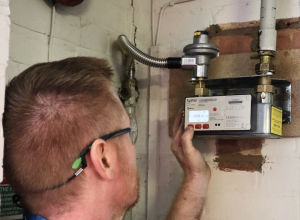A final attempt to simplify the much-criticised Carbon Reduction Commitment was announced in the Chancellor’s Autumn Statement towards the end of 2012. Sam Dean, Strategic Partner Channel Manager at IMServEurope Limited, the UK’s largest independent energy management provider, outlines both the changes to the CRC and how will it affect you.
A final attempt to simplify the much-criticised Carbon Reduction Commitment was announced in the Chancellor’s Autumn Statement towards the end of 2012. Sam Dean, Strategic Partner Channel Manager at IMServEurope Limited, the UK’s largest independent energy management provider, outlines both the changes to the CRC and how will it affect you.
The CRC Energy Efficiency Scheme (formerly known as the Carbon Reduction Commitment – CRC) is a mandatory carbon emissions Scheme to cover all organisations using more than 6,000MWh of electricity per year. The Scheme was introduced in April 2010, targeting emissions from large public and private sector organisations such as supermarkets, hotel chains, large offices and industrial facilities with the aim of driving emissions reductions and incentivising the uptake of energy efficiencies.
Prior to the recent changes, the ethos underpinning the CRC was the application of financial and PR drivers, i.e. in simple terms those organisations that were more energy efficient received a financial and reputation reward through the publication of a Performance League Table. This was prior to the UK’s austerity measures taking hold of CRC to re-examine its worth and value to the public purse.
Whilst the previous Scheme helped increase awareness of carbon reduction, it was not as successful at reducing energy costs. Despite savings of between 7% and 11% forsome organisations, it was reported that only 30% of councils experienced anyreduction in cost at all. The Scheme also received much criticism due to the complex system of rules, making the Scheme difficult to understand subsequently making it costly for participants to administer.
The simplification first proposed in March 2012, and set to come into force subject to approval on 1 June 2013, aims to radically reduce the amount of ‘red tape’ involved with participating in the CRC. The changes intend to save businesses an estimated £272m in administrative costs by 2030 while also ensuring industrial energy efficiency and carbon objectives are met.
How does the CRC work?
Many organisations’ local energy reductions are achieved through cost effective energy efficiency steps. However, tracking and influencing the effectiveness of energy efficiency initiatives takes a certain amount of intelligence as to where emissions arise, how often and if there are changes to the patterns. This is why the Scheme requires organisations to measure and report their carbon emissions in such detail. This information can be gained by installing smart metering and improved management systems to visualise and take steps to control usage, enabling significant costs savings to be made.
A variety of measures have been taken to simplify the Scheme for participants. Some of the key changes include:
The scrapping of the 90 per cent emissions rule, otherwise known as the ‘flexible de minimis’ rule, which required all participants to account for at least 90 per cent of their carbon footprint emissions. The rule aimed to focus attention on the largest and most cost effective opportunities to reduce carbon emissions. In reality however it caused significant administrative strain. The scrapping of the emissions rule also reduces the overlap between the CRC and other environmental regulations.
The Scheme will also be simplified by reducing the number of fuels that participants have to report against from 29 to 2. These are electricity and gas used for heating. Although this will lighten the administrative burden significantly, the reduction will result in the loss of some energy savings. However, it should be noted that “the loss of energy savings due to the removal of the overlap with Climate Change Agreements (CCAs) and EU Emissions Trading System (EU ETS) does not mean these energy savings are completely lost it just means they are not accounted for under the CRC,” said a spokesperson at the Department of Energy and Climate Change (DECC).
All state-funded schools in England have also been withdrawn from the Scheme. Prior to this change schools came under the umbrella of their local authority and as a result, immense pressure was often put on schools to reduce their carbon (with little guidance or access to tools in which to measure emissions) as substantial fines were imposed when targets were not met. The Government has announced that alternative robust measures to incentivise and support schools in England to save energy and emissions will be implemented, details of which are yet to be announced.
One of the other major changes to the Scheme has been the abolishment of the Performance League Table (PLT) a “published table detailing the relative performance of allparticipants in CRC against the three weighted metrics: absolute metric, earlyaction metric and growth metric”. The PLT was published annually with organisations performance set against key metrics, with the more successful being awarded top positions.
However the PLT has long attracted criticism in that the range, types and scale of organisations and their variety of portfolios is too varied to create a sensible comparison league table. Many organisations have argued that the PLT fails to recognise efforts made to reduce carbon by companies before the Scheme began. Further to this, in some markets participants within the Scheme found that by quirk of rules, their competitors were excluded.
Other CRC Energy Efficiency SchemeHighlights:
The CRC Energy Efficiency Scheme will continue in a simplified form, but may eventually be abolished and replaced with an alternative tax. A full review of the CRC Energy Efficiency Scheme is planned for 2016. The tax element of the CRC Energy Efficiency Scheme may be removed “when the public finances allow”. The Forecast Allowance Price remains unchanged at £12 per tonne of carbon dioxide in 2013-14, but will increase to £16 per tonne of carbon dioxide in 2014-15. From 2015-16 the Forecast Allowance Price will increase in line with the RPI. Reducing overlap with other Schemes (so that businesses covered entirely by CCAs (Climate Change Agreements) do not need to register; no longer requiring (EU ETS) EU Emissions Trading System installations to purchase allowances for electricity supplies)
For full details visit http://www.decc.gov.uk/en/content/cms/news/pn12_162/pn12_162.aspx
Future of CRC
The CRC Energy Efficiency Scheme is the only piece of legislation encouraging large organisations to measure and reduce their carbon emissions. Without a doubt this has boosted awareness of energy efficiency. It’s been reported that in some organisations senior management is taking note of energy bills for the first time. With the evidence provided through the original Carbon Reduction Commitment Scheme carbon and energy-related officers have been able to start an open dialogue with finance and resource teams in a way that they have never been able to in the past.
For now we can safely say that the CRC Scheme is here to stay in its simplified form. However, the Government has stated that a full review of the CRC Energy Efficiency Scheme effectiveness is planned for 2016 so its fate thereafter remains to be seen.
Organisations affected should look out for amended secondary legislation before 1 June 2013 and of course ensure they have all relevant information in preparation so they can report on energy use accurately and meet the obligations of the Scheme.
With the cost of energy rising, its efficient use is key to our future economic success. IMServ research and analysis shows that businesses can typically save up to 30% overall, with productivity, growth and profit increasing by implementing a hands on monitoring, visualisation and control strategy.
However, when developing energy saving strategies and policies it’s important not to forget that energy efficiency doesn’t stop with the monitoring, analysis and control tools. “People, not machines, make the decisions that affect energy use. Insight into the human dimension of energy use is key to better understanding future energy trends and how to act effectively to manage them.” Schipper and Meyers, Energy Efficiency and Human Activity. Cambridge: Cambridge University Press, 1993
Sam has offered 10 top tips for changing the internal behaviour of businesses, these include:
Create a company wide “Green” strategy encompassing water, heating, lighting et Appoint energy champions to increase energy consumption awareness to each department within the company. Publish the Corporate Social Responsibility (CSR) policy to employees and invite feedback on the sustainability strategy. Empower your employees;the simplest way to change attitudes is by presenting your employees with hard facts. Communicating your energy successes via an interactive Dashboard displayed in reception or on your organisations intranet can be particularly effective. Use communications tools at your disposal to make sure staff hear about the energy saving success of others, why not get creative and utilise social networks. Involve staff in the development of any scheme, this will empower them and increase the chances of success. Add an Energy saving KPI to any staff incentive scheme. Provide a company event using a percentage of the savings made from your employees effort towards carbon reduction and energy efficiency. Make behavioural changes easier by putting in place the correct infrastructure. For example office heating default settings, printer settings, light sensors to control usage etc. Remember cultural change takes time so take this into consideration when planning your strategy.
IMServ Europe Limited works closely with many FTSE 250 organisations and companies within the commercial and industrial sectors, advising on effective energy management solutions. The company offers a range of monitoring, visualisation and control services that allow businesses to gain greater insight into their energy usage.
The author
Sam Dean, Strategic Partner Channel Manager, heads up the partnering sales and strategic collaboration channel within IMServ. Sam’s experience includes twelve years of expertise within the energy sector, working for FTSE 100 organisations such as National Grid, Rolls Royce, Siemens Metering and IMServ within Leadership, Business Development and Head of Sales roles. Educated to degree and MBA standard with an understanding into the current market trends and demands of delivering a customer centric approach to monitoring, control and data intelligence.



